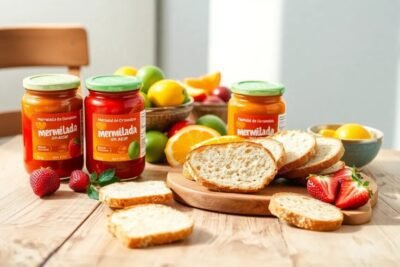
Delicious Diabetes-Friendly Cookie Recipes for Guilt-Free Indulgence
- Understanding Diabetes-Friendly Baking
- Essential Ingredients for Diabetes-Friendly Cookies
- Oatmeal Raisin Delight Recipe
- Cocoa Almond Crunch Cookie Recipe
- Peanut Butter Bliss Bites Recipe
- Tips for Baking and Storing Cookies
- Nutritional Profile of Diabetes-Friendly Cookies
- Incorporating Cookies into a Diabetic Meal Plan
- Engaging with Our Community
- Conclusion: Savoring Sweet Moments with Diabetes-Friendly Cookies
Understanding Diabetes-Friendly Baking
Baking with diabetes in mind is crucial for those who wish to enjoy sweet treats without compromising their health. It is essential to understand that certain ingredients can significantly influence blood sugar levels. For example, traditional sugars and high-carb flours can cause rapid spikes in glucose, making it vital for individuals with diabetes to find suitable alternatives.
When choosing ingredients, opt for those that have a lower glycemic index. Natural sweeteners such as stevia, erythritol, or monk fruit can effectively substitute traditional sugar while providing sweetness without the same impact on blood sugar. Additionally, whole-grain flours or nut flours, like almond or coconut flour, are preferable over white flour. These options not only add flavor and texture to cookie recipes but also increase fiber content, which is beneficial for blood sugar management.
In essence, diabetes-friendly baking is about making balanced choices. Individuals can still enjoy desserts by incorporating healthy fats, such as coconut oil or unsweetened applesauce, to enhance moisture while keeping calorie content reasonable. Reducing portion sizes can also help manage overall carbohydrate intake when indulging in cookies. Furthermore, adding ingredients such as oats, seeds, and nuts not only boosts the nutritional value of cookies but also contributes to satiety, making it easier to adhere to healthy eating habits.
As individuals embark on their journey of diabetes-friendly cooking, it is important to embrace creativity in the kitchen. Experimenting with flavors and textures can lead to delightful cookies that satisfy cravings while promoting health. By focusing on smart ingredient choices, maintaining balance, and enjoying treats in moderation, it is possible to savor sweet indulgences without jeopardizing one's health.
In crafting diabetes-friendly cookie recipes, the choice of ingredients plays a pivotal role. One of the primary concerns for individuals managing diabetes is the inclusion of refined sugars. Instead of traditional white sugar, opting for natural sweeteners such as stevia, erythritol, or monk fruit extract can significantly lower the glycemic impact of the cookies. These alternatives not only provide sweetness without the spike in blood sugar levels but are also lower in calories, making them ideal for those looking to indulge guilt-free.
The type of flour used in cookie recipes is another fundamental consideration when creating diabetes-friendly treats. Instead of standard all-purpose flour, which has a higher glycemic index, whole grain flours such as almond flour and coconut flour can be excellent substitutes. Almond flour is rich in fiber and healthy fats, which help regulate blood sugar levels, while coconut flour absorbs moisture well and adds a subtle sweetness without sacrificing taste. Other alternatives like oat flour can also deliver beneficial nutrients and a lower glycemic response.
The choice of fats in your cookie recipes is equally crucial. Healthy fats, such as those derived from avocados, nut butters, or coconut oil, can enhance flavor while offering important health benefits. These fats not only improve the texture of cookies but also increase satiety, which may prevent overeating. When creating diabetes-friendly cookie recipes, it is essential to focus on balancing sweeteners, flours, and fats to ensure that the final product is not only delicious but also supports overall health. By incorporating these ingredients thoughtfully, bakers can create delightful cookies that align with dietary needs without compromising on taste or quality.
Oatmeal Raisin Delight Recipe
For those seeking a delectable yet diabetes-friendly treat, oatmeal raisin cookies are an excellent choice. This recipe combines wholesome ingredients that not only satisfy your sweet cravings but also keep your blood sugar levels in check. Below is the step-by-step guide to creating Oatmeal Raisin Delight cookies.
Ingredients:
- 1 cup rolled oats
- 1 cup whole wheat flour
- 1/2 cup unsweetened applesauce
- 1/4 cup honey or a sugar substitute suitable for baking
- 1/2 cup raisins
- 1/4 cup chopped walnuts (optional)
- 1 teaspoon cinnamon
- 1/2 teaspoon baking powder
- 1/4 teaspoon salt
- 1/4 cup unsweetened almond milk or water
Preparation Steps:
- Preheat your oven to 350°F (175°C).
- In a large mixing bowl, combine rolled oats, whole wheat flour, cinnamon, baking powder, and salt.
- In a separate bowl, mix the unsweetened applesauce with honey until well incorporated.
- Gradually combine the wet ingredients with the dry ingredients, stirring gently to avoid overmixing. Add almond milk or water as needed to achieve a cookie dough consistency.
- Fold in the raisins and walnuts if using, ensuring they are evenly distributed throughout the dough.
Baking Instructions:
- Line a baking sheet with parchment paper.
- Using a tablespoon, drop rounded portions of dough onto the baking sheet, spacing them about 2 inches apart.
- Bake for 12-15 minutes, or until the edges are golden brown.
- Allow the cookies to cool on the baking sheet for a few minutes before transferring them to a wire rack to cool completely.
For enhanced taste and texture, consider using old-fashioned rolled oats instead of instant oats, as they provide a chewier bite. Additionally, storing these cookies in an airtight container will maintain their freshness. Enjoy these delightful oatmeal raisin cookies as a satisfying diabetes-friendly snack!
For those who seek a delectable treat that aligns with diabetes-friendly cookie recipes, Cocoa Almond Crunch cookies stand out as an excellent option. This recipe not only satisfies chocolate cravings but also prioritizes health by incorporating ingredients that have minimal impact on blood sugar levels. Below is a comprehensive guide to crafting this delicious cookie.
Ingredients:
- 1 cup almond flour
- 1/4 cup unsweetened cocoa powder
- 1/2 cup erythritol or another sugar substitute
- 1/4 teaspoon baking soda
- 1/4 teaspoon salt
- 1/4 cup coconut oil, melted
- 1 large egg
- 1 teaspoon vanilla extract
- 1/2 cup dark chocolate chips (sugar-free)
- 1/4 cup chopped almonds
Preparation Steps:
- Preheat the oven to 350°F (180°C) and line a baking sheet with parchment paper.
- In a medium bowl, combine the almond flour, cocoa powder, erythritol, baking soda, and salt. Mix thoroughly.
- In a separate bowl, whisk together the melted coconut oil, egg, and vanilla extract until combined.
- Gradually pour the wet mixture into the dry ingredients, stirring until a dough forms. Fold in the dark chocolate chips and chopped almonds.
- Use a tablespoon to scoop out portions of the dough and shape them into balls. Place them on the prepared baking sheet, flattening them slightly with your palm.
- Bake for 12-15 minutes, or until the edges are firm. Once done, allow the cookies to cool on a wire rack.
These cookies not only provide a delightful crunch but are also packed with the nutritional benefits of almonds and cocoa. Almond flour offers a low-carb alternative to traditional flour while cocoa powder is rich in antioxidants. This recipe emphasizes not only enjoyment but also well-being, making it a smart addition to any diabetes-friendly cookie recipes collection.
Peanut Butter Bliss Bites Recipe
Indulging in a sweet treat is entirely possible, even for those managing diabetes, with our Peanut Butter Bliss Bites. This delightful cookie recipe utilizes natural sweeteners, ensuring you can enjoy a guilt-free snack without compromising your health. To create these cookies, you will need the following ingredients:
- 1 cup natural peanut butter (unsweetened)
- 1/3 cup erythritol or another diabetes-friendly sweetener
- 1 teaspoon vanilla extract
- 1 large egg
- 1/4 teaspoon baking soda
- A pinch of salt
Begin by preheating your oven to 350°F (175°C). In a medium-sized mixing bowl, combine the natural peanut butter, erythritol, and vanilla extract. Mix these ingredients together thoroughly, ensuring there are no lumps. This combination serves as a rich and flavorful base for your cookies, providing both nutrition and taste.
Once the initial ingredients are well-blended, add the egg, baking soda, and a pinch of salt. Stir the mixture until a sticky dough forms. For added flavor, consider incorporating sugar-free chocolate chips or chopped nuts, which can enhance the texture and taste of these peanut butter cookies.
Using a tablespoon, scoop the dough onto a parchment-lined baking sheet, spacing them about two inches apart. Flatten each cookie slightly with the back of the spoon to create an even shape. Bake in the preheated oven for 10-12 minutes or until the edges are lightly golden. After baking, allow the cookies to cool on the baking sheet for a few minutes prior to transferring them to a wire rack.
These Peanut Butter Bliss Bites not only satisfy your sweet tooth but also align with diabetes-friendly guidelines. Their simplicity and rich taste make them a beloved choice among cookie recipes tailored for those managing their dietary restrictions.
When it comes to baking diabetes-friendly cookie recipes, successful indulgence does not only lie in the ingredients used but also in how these cookies are stored and enjoyed. Proper storage is essential to retain the freshness and flavors of these delightful treats. After baking, allow your cookies to cool completely on a wire rack. This ensures that they do not continue to cook and become overly dry.
Once cooled, the best way to store your cookies is in an airtight container at room temperature. This prevents moisture loss and helps maintain the soft texture of the cookies. For longer storage, consider refrigerating them. However, it is essential to allow them to come to room temperature before consumption to enjoy their optimal taste and texture. You can also keep the cookies in the refrigerator for up to a week, but a well-sealed container will help protect them from absorbing any other odors.
If you want to prepare your diabetes-friendly cookies ahead of time, freezing is an excellent option. Place baked cookies in an airtight freezer bag or container, ensuring to remove as much air as possible to avoid freezer burn. Label the container with the date and type of cookie, as most cookies can be successfully stored this way for up to three months. To enjoy later, remove the desired amount of cookies from the freezer and let them thaw in the refrigerator or at room temperature. Reheating them briefly in the microwave can bring back their delightful freshness. Consider serving size as well; smaller portions can help manage blood sugar levels while still allowing for a sweet treat.
By following these storage methods, you can ensure that your diabetes-friendly cookie recipes remain delicious and enjoyable for longer periods, allowing for guilt-free indulgence whenever the craving strikes.
When it comes to treating oneself while managing diabetes, the nutritional profile of each ingredient in diabetes-friendly cookie recipes plays a pivotal role. Many of these recipes utilize alternatives to traditional ingredients, thereby lowering the glycemic index and making them conducive for blood sugar management. For instance, almond flour is often used instead of white flour; it is low in carbohydrates and high in healthy fats, providing a slow release of energy which is ideal for maintaining stable blood sugar levels.
Furthermore, the sweeteners used in these recipes are typically natural and low in calories. Ingredients like stevia or erythritol provide the sweetening effect without the sharp rise in blood glucose commonly associated with refined sugars. The caloric content of these cookies is also usually lower, making them a suitable treat even when adhering to a calorie-controlled diet.
Additionally, featuring fiber-rich ingredients such as oats, chia seeds, or ground flaxseed can improve digestive health. Fiber aids in slowing sugar absorption, which is particularly beneficial for individuals with diabetes. Other nutritious additions, such as dark chocolate or nuts, not only elevate the flavor but also bolster the health quotient of these cookies. Dark chocolate, rich in antioxidants, can even enhance heart health while nuts provide protein and healthy fats.
When selecting recipes, individuals with diabetes should also pay attention to serving sizes. Most diabetes-friendly cookie recipes are designed to yield manageable portions, allowing for mindful consumption. By incorporating ingredients that are low in refined sugars and high in beneficial nutrients, these recipes offer a guilt-free way for individuals to satisfy their sweet tooth while adhering to a balanced diet. This broadens the scope of enjoyable treats and reinforces healthy eating patterns.
Incorporating diabetes-friendly cookie recipes into a balanced meal plan can enhance satisfaction while still being mindful of blood sugar levels. These cookies can serve as a delightful treat, but moderation is key to maintaining a healthy diet. Understanding portion sizes is crucial; typically, a serving size of these cookies should be aligned with the carbohydrate content recommended by dietary guidelines. For instance, enjoying one or two small cookies can provide a satisfying boost without overwhelming your daily carbohydrate allowance.
Pairing these cookies with nutritious accompaniments further enhances their inclusion in a diabetic meal plan. For example, consider enjoying a cookie alongside a source of protein or healthy fat, such as a handful of nuts or a small serving of Greek yogurt. This strategy not only balances the meal but can also help in stabilizing blood sugar levels. Alternatively, a cookie can be enjoyed as part of an afternoon snack with a piece of fruit, allowing you to satisfy your sweet tooth while consuming essential nutrients.
Additionally, it is beneficial to prepare cookies using whole grain flours, low-calorie sweeteners, and healthy fats, ensuring that they remain diabetes-friendly. When planning your meals, include these cookies within a framework of fiber-rich foods and lean proteins to achieve a harmonious balance. Regularly incorporating a small quantity of these treats will help you avoid feelings of deprivation, making it easier to adhere to your meal plan. In conclusion, with careful planning and mindfulness, diabetes-friendly cookie recipes can be enjoyed as part of a well-rounded diet, allowing you to indulge without guilt while maintaining your health.
Engaging with Our Community
At the heart of our platform, we believe in the power of shared experiences, especially when it comes to baking delicious diabetes-friendly cookie recipes. We invite you to become an active member of our community, where sharing your baking journey can inspire others facing similar dietary challenges. Whether you have modifications you’ve made to the recipes or new ingredients you’ve tested, we encourage you to share your insights with fellow enthusiasts. Your contributions could make a significant difference in someone's baking adventures.
Have you recently tried one of our diabetes-friendly cookie recipes? If so, we would love for you to tell us about your experience. Did you find the cookies to be as enjoyable as you had hoped? Perhaps you discovered a unique twist that enhanced the flavors or the health benefits of the cookies. Sharing these modifications not only adds variety to our collection but also helps others in their quest for tasty, health-conscious treats. Every recipe can benefit from personal touches, and your creativity can provide fresh ideas for others looking to indulge guilt-free.
Additionally, engaging with our community is not just about sharing recipes; it’s about creating a supportive environment. Discuss the benefits you’ve experienced from choosing diabetes-friendly options, whether it’s improved health markers or simply satisfying your sweet tooth without the guilt. These conversations foster a sense of belonging, encouraging others to participate and build connections. Your voice is essential, and we believe that every contribution enriches our collective journey toward healthier lifestyles.
We look forward to hearing your stories and seeing how our recipes have impacted your baking experiences. Join us in this community venture, and let’s continue to explore the delightful world of diabetes-friendly baking together!
In this blog post, we have explored a variety of delicious diabetes-friendly cookie recipes that prove indulging in sweet treats does not have to be off-limits for those managing diabetes. Through thoughtful ingredient selections and innovative baking techniques, these recipes offer a guilt-free way to enjoy cookies without significantly impacting blood sugar levels.
We've emphasized the importance of using natural sweeteners, whole grains, and healthy fats, which not only contribute to the flavor of the cookies but also help maintain stable glucose levels. By opting for ingredients such as almond flour, oats, or coconut flour, one can create delightful cookies that are not only satisfying but also aligned with diabetes-friendly guidelines. Furthermore, incorporating nuts and seeds can add beneficial nutrients and texture, enhancing the overall cookie experience.
As highlighted in the various recipes discussed, moderation is key. While these cookies are crafted with health-conscious choices in mind, it is essential to practice portion control to maintain overall well-being. Enjoying cookies as part of a balanced diet can bring joy without compromising health. We encourage readers to experiment with baking their own diabetes-friendly cookies, customizing recipes with personal preferences and dietary needs in mind.
Embracing the art of baking can be a fulfilling aspect of diabetes management, allowing individuals to savor sweet moments without guilt. We hope this blog inspires you to further explore our portal for more recipes and tips on living well with diabetes. Baking can be both a creative outlet and a means of maintaining a health-conscious lifestyle, ensuring that you can enjoy the delicious treats you love in a manner that aligns with your health goals.







